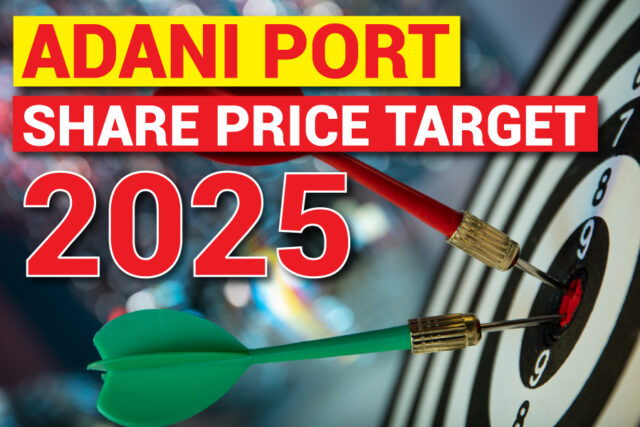As an investor, I am always on the lookout for promising companies that can yield substantial returns in the long run. Adani Port, a subsidiary of the Adani Group, has caught my attention with its impressive growth trajectory and ambitious expansion plans. This article delves into the potential of Adani Port’s share price target for 2025 and explores various factors that could influence its performance.
Adani Port is a leading integrated logistics player in India, operating a network of ports across the country’s coastline. With a strategic focus on enhancing infrastructure and leveraging cutting-edge technology, the company has established itself as a formidable force in the maritime and logistics sector.
Understanding Share Price Targets
Before diving into the specifics of Adani Port’s share price target for 2025, it’s essential to understand the concept of share price targets. A share price target is an estimated future value of a company’s stock based on various factors, including financial performance, industry trends, and market conditions. These targets are typically set by analysts and investment firms, providing investors with a reference point for their investment decisions. Share price targets are not set in stone; they are subject to revision as new information emerges or circumstances change. However, they offer valuable insights into a company’s potential growth and can guide investors in making informed decisions.
Factors Influencing Adani Port Share Price In 2025
Several factors could influence Adani Port’s share price target for 2025. Let’s explore some of the key drivers:
Economic Growth And Trade Dynamics: Adani Port’s fortunes are closely tied to India’s economic growth and international trade activities. As the Indian economy continues to expand and trade volumes increase, the demand for efficient logistics and port services will surge, potentially boosting Adani Port’s revenue and profitability.
Infrastructure Development: The Indian government’s emphasis on infrastructure development, particularly in the logistics and transportation sectors, bodes well for Adani Port. Ongoing projects such as the Dedicated Freight Corridor and the Sagarmala Program could create new opportunities for the company to expand its operations and capture a larger market share.
Technological Advancements: Adani Port has been at the forefront of adopting cutting-edge technologies to streamline operations and enhance efficiency. Continued investments in automation, digitalization, and sustainable practices could give the company a competitive edge and drive cost savings, ultimately contributing to its bottom line.
Strategic Acquisitions And Partnerships: Adani Port has demonstrated a keen interest in strategic acquisitions and partnerships to expand its reach and diversify its service offerings. Any successful ventures in this direction could unlock new revenue streams and strengthen the company’s market position.
Analysis Of Adani Port’s Current Financial Performance
To gauge Adani Port’s potential for achieving its share price target in 2025, it’s crucial to analyze its current financial performance. Here’s a snapshot of the company’s recent financial metrics:
- Revenue Growth: Adani Port has consistently reported impressive revenue growth over the past few years, driven by increased cargo volumes and operational efficiency. In the financial year 2022-23, the company’s revenue grew by a staggering 25% compared to the previous year.
- Profitability Margins: Despite facing challenges posed by the COVID-19 pandemic, Adani Port has maintained healthy profitability margins. The company’s EBITDA (Earnings Before Interest, Taxes, Depreciation, and Amortization) margin stood at an impressive 68% in the financial year 2022-23, indicating strong operational efficiency.
- Debt Management: Adani Port has been proactive in managing its debt levels, ensuring a sustainable capital structure. The company’s debt-to-equity ratio stands at a comfortable level of 0.6, providing financial flexibility for future growth initiatives.
- Return On Equity (ROE): Adani Port’s ROE, a measure of profitability in relation to shareholders’ equity, has been consistently above 15%, signaling the company’s ability to generate attractive returns for its investors.
These financial metrics paint a positive picture of Adani Port’s current performance, positioning the company favorably to achieve its share price target in 2025.
Expert Opinions On Adani Port’s Growth Potential
Industry experts and analysts have expressed optimism regarding Adani Port’s growth prospects. Here are some notable opinions:
“Adani Port’s strategic focus on expanding its logistics footprint, coupled with its commitment to operational excellence, positions the company well for sustained growth in the coming years.” – Anita Kapoor, Equity Research Analyst, Motilal Oswal Financial Services.
“The Indian logistics sector is poised for a transformative phase, and Adani Port is well-positioned to capitalize on this opportunity. Their investments in technology and infrastructure will be key drivers of their future success.” – Rajesh Sharma, Director, Logistics and Supply Chain Practice, Deloitte India.
“Adani Port’s diversified portfolio of ports and strategic partnerships with global players give them a competitive edge in the market. Their focus on sustainability and innovation further strengthens their value proposition.” – Sanjay Gupta, Managing Director, India Ratings and Research.
These expert opinions highlight confidence in Adani Port’s growth potential, which is driven by its strategic initiatives, operational efficiency, and commitment to innovation.
Potential Risks And Challenges For Adani Port In Achieving The Target
While the prospects for Adani Port appear promising, it’s essential to consider potential risks and challenges that could hinder the company’s ability to achieve its share price target in 2025:
- Global Economic Uncertainties: Adani Port’s operations are heavily influenced by international trade dynamics. Any significant economic downturn or trade disruptions could adversely impact cargo volumes and revenue streams.
- Competition And Market Saturation: The Indian logistics and port sector is highly competitive, with established players and new entrants vying for market share. Adani Port may face intense competition, which could affect its pricing power and profitability margins.
- Regulatory And Policy Changes: Changes in government policies, regulations, and taxation frameworks related to the logistics and maritime sectors could impact Adani Port’s operations and future expansion plans.
- Environmental And Social Concerns: As the focus on sustainability and environmental responsibility grows, Adani Port may face increased scrutiny and pressure to adopt more stringent environmental practices, potentially increasing operational costs.
- Geopolitical Tensions: Geopolitical tensions and conflicts in regions where Adani Port operates or sources cargo could disrupt supply chains and impact the company’s operations.
While these risks and challenges are not unique to Adani Port, they highlight the importance of careful risk management and adaptability to navigate potential headwinds successfully.
Comparison With Other Similar Companies In The Industry
To better understand Adani Port’s potential, it’s instructive to compare its performance and prospects with other similar companies in the industry. Here’s a brief comparison:
- Adani Port Vs. Mundra Port: Mundra Port, a subsidiary of the Adani Group, is a direct competitor to Adani Port. While Mundra Port has a strong presence in the western region of India, Adani Port’s diversified portfolio of ports across the country gives it a broader reach and potential for growth.
- Adani Port Vs. Gujarat Pipavav Port: Gujarat Pipavav Port, operated by APM Terminals, is another major player in the Indian port sector. However, Adani Port’s focus on technological advancements and operational efficiency could give it a competitive edge in the long run.
- Adani Port Vs. Krishnapatnam Port: Krishnapatnam Port, a private port in Andhra Pradesh, has been making strides in the industry. However, Adani Port’s larger scale of operations, strategic partnerships, and financial strength position it as a formidable competitor.
While these comparisons provide insights, it’s important to note that each company operates under unique circumstances and market conditions. Adani Port’s ability to capitalize on its strengths and mitigate risks will ultimately determine its success in achieving its share price target.
Steps To Consider Before Investing In Adani Port
Before making an investment decision regarding Adani Port, I recommend considering the following steps:
- Conduct Thorough Research: Gather comprehensive information about Adani Port’s business model, financial performance, management team, and competitive landscape. Analyze industry reports, analyst recommendations, and company disclosures to make an informed decision.
- Assess Risk Tolerance: Evaluate your personal risk tolerance and investment objectives. Adani Port operates in a capital-intensive industry, and its share price may experience volatility. Ensure that the potential risks align with your investment strategy.
- Diversify Your Portfolio: While Adani Port may present attractive growth prospects, it’s crucial to maintain a diversified portfolio to mitigate risk. Consider allocating a portion of your investment to Adani Port while balancing it with other sectors and asset classes.
- Monitor Market Conditions: Stay updated on market trends, industry developments, and any significant events that could impact Adani Port’s performance. Regularly review your investment strategy and make adjustments as necessary.
- Seek Professional Advice: If you are unsure about any aspect of investing in Adani Port, consider seeking guidance from a qualified financial advisor who can provide personalized recommendations based on your specific financial situation and goals.
By following these steps, you can make an informed decision about investing in Adani Port, aligning your investment with your risk tolerance and long-term objectives.
Long-Term Investment Strategies For Adani Port
For investors with a long-term investment horizon, Adani Port presents several potential strategies:
Buy And Hold
Adani Port’s strong fundamentals, growth prospects, and strategic initiatives make it an attractive candidate for a buy-and-hold strategy. This approach involves purchasing shares and holding them for an extended period, allowing the company’s growth to drive capital appreciation over time.
Dollar-Cost Averaging
To mitigate the impact of market volatility, investors can consider a dollar-cost averaging strategy. This involves investing a fixed amount of money in Adani Port shares at regular intervals, regardless of the share price. This approach can help smooth out the effects of market fluctuations and potentially lower the overall cost basis.
Dividend Reinvestment
Adani Port has a history of paying dividends to its shareholders. Investors can opt for a dividend reinvestment plan (DRIP), which automatically reinvests dividends into additional shares. This strategy can compound returns over time and increase an investor’s stake in the company.
Portfolio Rebalancing
As part of a diversified portfolio, investors should periodically rebalance their holdings to maintain their desired asset allocation. This may involve adjusting the weightage of Adani Port shares in their portfolio based on their performance and market conditions.
Tactical Allocation
For more active investors, a tactical allocation strategy can be employed. This involves adjusting the exposure to Adani Port shares based on market conditions, valuations, and the company’s performance relative to its peers.
Conclusion
Based on the analysis and factors discussed in this article, Adani Port presents a compelling investment opportunity for those seeking long-term growth and returns. The company’s strong financial performance, strategic initiatives, and favorable industry dynamics position it well to achieve its share price target in 2025. However, it’s crucial to consider the potential risks and challenges that Adani Port may face, such as global economic uncertainties, competition, regulatory changes, and environmental concerns.
Investors should carefully evaluate their risk tolerance and investment objectives before making a decision. Ultimately, the decision to invest in Adani Port should be based on a thorough understanding of the company, the industry, and one’s personal financial goals. By conducting comprehensive research, seeking professional advice if needed, and adopting a disciplined long-term investment strategy, investors can potentially unlock the potential of Adani Port’s share price target in 2025.














